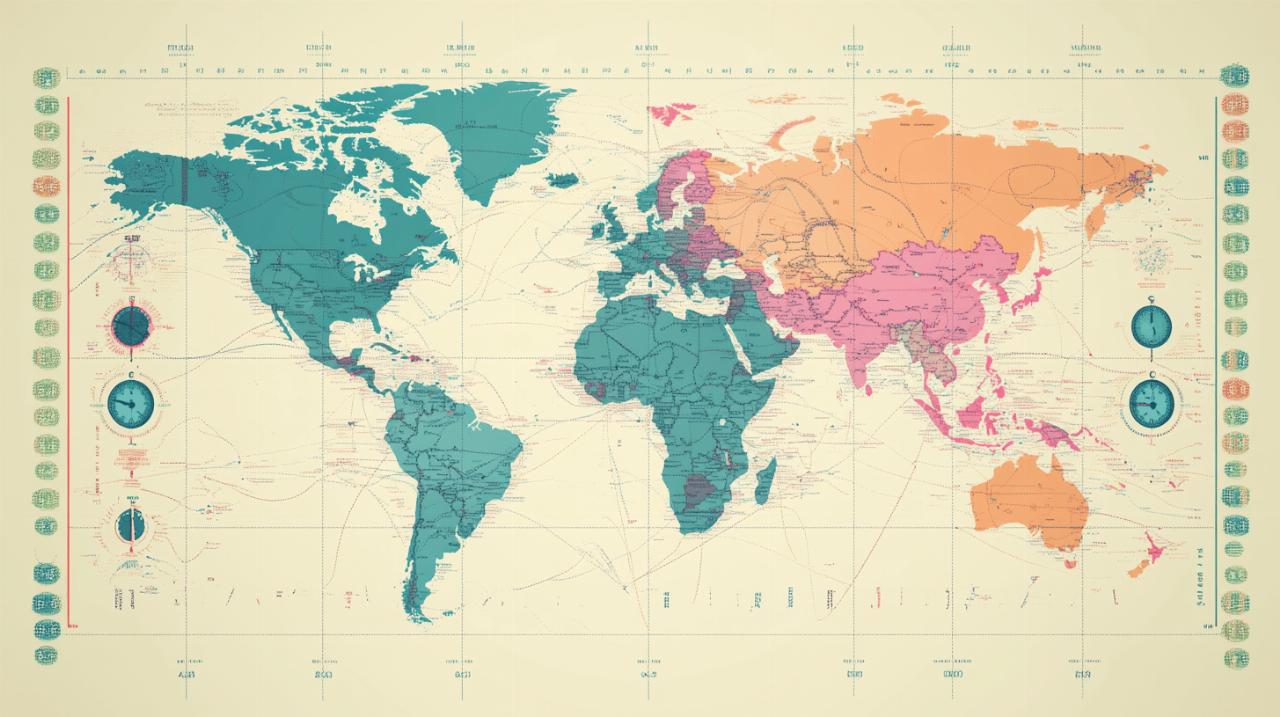Navigating the Time Difference Between Luxembourg and the Entire World: Practical Tips for Maintaining Peak Cognitive Function Whilst Travelling
Travelling from Luxembourg to destinations across the globe requires more than simply packing your bags and booking a flight. Understanding how time zones affect your body and mind is essential, particularly if you wish to arrive at your destination with your cognitive faculties intact. Whether you are heading west to the Americas or east towards Asia, the shift in hours can place unexpected demands on your brain, disrupting your sleep patterns and leaving you foggy for days. Preparing in advance and employing a few well-chosen strategies can make all the difference in maintaining your mental sharpness and ensuring you are ready to engage fully with your new surroundings.
Understanding luxembourg's time zones and global positioning
Central european time and seasonal adjustments explained
Luxembourg operates on Central European Time, which places it one hour ahead of Coordinated Universal Time during the standard period. When clocks in Greenwich read noon, it is already one o'clock in the afternoon in Luxembourg. This arrangement continues until the arrival of warmer months, when the nation transitions to Central European Summer Time, pushing the clock forward by an additional hour to UTC plus two. This seasonal adjustment mirrors the practice in much of Europe, designed to make better use of daylight during the longer days of summer. For travellers, this means that the time difference between Luxembourg and other regions fluctuates depending on the season, and it is wise to verify the current offset before finalising travel plans. Missing a dinner reservation or an important meeting due to a miscalculation of hours is an inconvenience best avoided, especially after a long journey.
Comparing luxembourg's clock with key global regions
When considering travel from Luxembourg to other parts of the world, the time differences can be substantial. Neighbouring countries such as France and Belgium follow the same clock, so travellers moving within this region need not worry about adjusting their watches. However, venturing further afield reveals more significant gaps. For instance, those flying in from the eastern seaboard of the United States will contend with a difference of five or six hours, depending on whether daylight saving time is in effect. Heading west to the Pacific coast increases this gap even further. Conversely, travellers arriving from Asia may find themselves several hours ahead, which can complicate scheduling and exacerbate the effects of jet lag. The United Kingdom, despite its proximity, operates on Greenwich Mean Time in winter and British Summer Time in summer, placing it one hour behind Luxembourg for much of the year. This seemingly modest difference can catch unwary travellers off guard, particularly when coordinating flights or arranging pickups. Always cross-reference the local time in Luxembourg with Coordinated Universal Time to ensure accuracy and avoid unnecessary confusion.
Practical Strategies for Managing Jet Lag and Time Zone Shifts
Pre-travel preparation to minimise cognitive disruption
The key to preserving your mental acuity during international travel lies in preparation that begins well before you board the aircraft. Gradually shifting your sleep schedule in the days leading up to departure can ease the transition. If you are travelling eastward, try going to bed an hour earlier each night for several nights before your flight. Conversely, if your destination is to the west, staying up a bit later can help your body adjust to the later time zone. This incremental approach allows your internal clock to begin adapting before the abrupt shift imposed by crossing multiple time zones. Additionally, consider the timing of your flight. Overnight flights that align with your usual sleep hours can help you arrive rested, whereas daytime flights may leave you awake for an extended period, compounding the effects of jet lag. Planning your itinerary with these factors in mind can significantly reduce the cognitive fog that often accompanies long-distance travel.
In-Flight and Post-Arrival Techniques for Swift Adjustment
Once aboard the aircraft, your focus should shift to managing your environment to support rest and alertness. Set your watch to the time at your destination as soon as you board, which can help mentally prepare you for the new schedule. If it is night-time at your destination, attempt to sleep during the flight by using an eye mask and earplugs to block out distractions. On the other hand, if it is daytime where you are heading, stay awake and engage in light activities such as reading or watching a film. Upon arrival, resist the temptation to nap immediately, regardless of how tired you feel. Instead, expose yourself to natural daylight, which is one of the most effective ways to reset your circadian rhythm. A brisk walk outdoors or simply sitting in a sunny spot can signal to your brain that it is time to be awake and alert. By evening, aim to go to bed at a reasonable local hour, even if you do not feel particularly sleepy. This discipline in the first day or two after arrival can accelerate your adjustment and restore your cognitive function more quickly.
Maintaining mental sharpness across multiple time zones
Sleep hygiene and circadian rhythm management
 Your circadian rhythm, the internal clock that governs sleep and wakefulness, is heavily influenced by light exposure and consistency in your daily routine. When travelling across time zones, maintaining good sleep hygiene becomes even more critical. Create a restful environment in your accommodation by ensuring the room is dark, quiet and cool. If external noise is an issue, use earplugs or a white noise application to drown out disturbances. Avoid screens emitting blue light, such as smartphones and tablets, in the hour before bed, as this type of light can suppress the production of melatonin, the hormone that promotes sleep. Instead, consider reading a physical book or practising relaxation techniques such as deep breathing or gentle stretching. Consistency in your sleep schedule, even while travelling, reinforces your circadian rhythm and helps prevent the disorientation that can undermine your cognitive abilities. Remember that your brain relies on predictable patterns to function optimally, and disrupting these patterns unnecessarily can lead to sluggish thinking and impaired decision-making.
Your circadian rhythm, the internal clock that governs sleep and wakefulness, is heavily influenced by light exposure and consistency in your daily routine. When travelling across time zones, maintaining good sleep hygiene becomes even more critical. Create a restful environment in your accommodation by ensuring the room is dark, quiet and cool. If external noise is an issue, use earplugs or a white noise application to drown out disturbances. Avoid screens emitting blue light, such as smartphones and tablets, in the hour before bed, as this type of light can suppress the production of melatonin, the hormone that promotes sleep. Instead, consider reading a physical book or practising relaxation techniques such as deep breathing or gentle stretching. Consistency in your sleep schedule, even while travelling, reinforces your circadian rhythm and helps prevent the disorientation that can undermine your cognitive abilities. Remember that your brain relies on predictable patterns to function optimally, and disrupting these patterns unnecessarily can lead to sluggish thinking and impaired decision-making.
Nutrition and Hydration Tips for Optimal Brain Function
What you consume during your travels can have a profound impact on how well your brain copes with the demands of shifting time zones. Staying hydrated is paramount, as dehydration can exacerbate feelings of fatigue and reduce your ability to concentrate. Aim to drink water regularly throughout your journey, particularly on the aircraft where cabin air tends to be dry. Avoid excessive caffeine, especially in the hours leading up to bedtime at your destination, as it can interfere with your ability to fall asleep. While a cup of coffee or tea can provide a useful boost during the day, moderation is key. Similarly, limit your intake of alcohol, which may initially make you feel drowsy but ultimately disrupts the quality of your sleep. When it comes to meals, choose foods that are light and easy to digest rather than heavy, rich dishes that can leave you feeling sluggish. Incorporate plenty of fruits, vegetables and lean proteins, which provide sustained energy without causing dramatic spikes and crashes in blood sugar levels. By paying attention to what you eat and drink, you support not only your physical wellbeing but also the cognitive resilience needed to navigate new environments and engage meaningfully with the people and places you encounter.
Essential Tools and Resources for Global Travellers
Reliable time zone conversion applications and websites
In an age where technology can simplify even the most complex tasks, there is no shortage of tools designed to help travellers manage time differences. Numerous applications and websites offer real-time conversions, allowing you to see at a glance what time it is in Luxembourg compared to any other location in the world. These platforms often include features such as daylight saving time adjustments and the ability to set alarms or reminders based on multiple time zones. Some applications even allow you to create a list of your most frequently travelled destinations, making it easier to coordinate meetings or calls with colleagues and friends. When selecting a tool, look for one that is regularly updated to reflect changes in time zone regulations, as these can occasionally shift due to political or economic decisions. Relying on accurate, up-to-date information reduces the risk of errors and ensures that you remain punctual and organised, no matter how far from home you roam.
Scheduling Appointments and Reservations Without the Confusion
One of the most frustrating aspects of international travel is coordinating appointments, reservations and calls when everyone involved is operating on different clocks. To avoid confusion, always confirm the time zone when making arrangements. Rather than simply stating a time, specify whether you are referring to Luxembourg time or the local time of your contact. For written communication, consider using Coordinated Universal Time as a neutral reference point, which can then be converted by all parties as needed. When booking restaurants, transportation or meetings, double-check the local time at your destination and set reminders on your phone or calendar that account for the time difference. Many digital calendars now automatically adjust for time zones, but it is still prudent to verify these settings before relying on them. A little extra diligence in this area can prevent missed flights, lost reservations and the embarrassment of arriving at the wrong hour. By taking these precautions, you ensure that your travel experience remains smooth and that your cognitive energy is reserved for the activities and interactions that truly matter, rather than being squandered on avoidable logistical mishaps.
